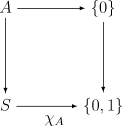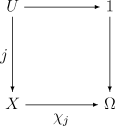Subobject classifier
In category theory, a subobject classifier is a special object Ω of a category; intuitively, the subobjects of an object X correspond to the morphisms from X to Ω. As the name suggests, what a subobject classifier does is to identify/classify subobjects of a given object according to which elements belong to the subobject in question. Because of this role, the subobject classifier is also referred to as the "truth value object". In fact, the way in which the subobject classifier classifies subobjects of a given object is by assigning the values true to elements belonging to the subobject in question, and false to elements not belonging to the subobject. This is why the subobject classifier is widely used in the categorical description of logic.
Introductory example
As an example, the set Ω = {0,1} is a subobject classifier in the category of sets and functions: to every subset A of S defined by the inclusion function j : A → S we can assign the function χA from S to Ω that maps precisely the elements of A to 1 (see characteristic function). Every function from S to Ω arises in this fashion from precisely one subset A.
To be clearer, consider a subset A of S (A ⊆ S), where S is a set. The notion of being a subset can be expressed mathematically using the so-called characteristic function χA : S → {0,1}, which is defined as follows:
(Here we interpret 1 as true and 0 as false.) The role of the characteristic function is to determine which elements belong to the subset A. In facts, χA is true precisely on the elements of A.
In this way, the collection of all subsets of S, denoted by P(S), and the collection of all maps from S to Ω = {0,1}, denoted by ΩS, are isomorphic.
To categorize this notion, recall that, in category theory, a subobject is actually a pair consisting of an object and a monic arrow (interpreted as the inclusion into another object). Accordingly, true refers to the element 1, which is selected by the arrow: true: {0} → {0, 1} that maps 0 to 1. The subset A of S can now be defined as the pullback of true along the characteristic function χA, shown on the following diagram:

Defined that way, χ is a morphism SubC(S) → HomC(S, Ω). By definition, Ω is a subobject classifier if this morphism is an isomorphism.
Definition
For the general definition, we start with a category C that has a terminal object, which we denote by 1. The object Ω of C is a subobject classifier for C if there exists a morphism
- 1 → Ω
with the following property:
- For each monomorphism j: U → X there is a unique morphism χ j: X → Ω such that the following commutative diagram

- is a pullback diagram—that is, U is the limit of the diagram:

The morphism χ j is then called the classifying morphism for the subobject represented by j.
Further examples
Every elementary topos, defined as a category with finite limits and power objects, necessarily has a subobject classifier.[1] For the topos of sheaves of sets on a topological space X, it can be described in these terms: For any open set U of X, is the set of all open subsets of U. Roughly speaking an assertion inside this topos is variably true or false, and its truth value from the viewpoint of an open subset U is the open subset of U where the assertion is true. A quasitopos has an object that is almost a subobject classifier; it only classifies strong subobjects.
For a small category , the subobject classifer in the topos of presheaves is the functor sending any to the set of sieves on .
Notes
- ↑ Pedicchio & Tholen (2004) p.8
References
- Artin, Michael; Alexander Grothendieck; Jean-Louis Verdier (1964). Séminaire de Géometrie Algébrique IV. Springer-Verlag.
- Barr, Michael; Charles Wells (1985). Toposes, Triples and Theories. Springer-Verlag. ISBN 0-387-96115-1.
- Bell, John (1988). Toposes and Local Set Theories: an Introduction. Oxford: Oxford University Press.
- Goldblatt, Robert (1983). Topoi: The Categorial Analysis of Logic. North-Holland, Reprinted by Dover Publications, Inc (2006). ISBN 0-444-85207-7.
- Johnstone, Peter (2002). Sketches of an Elephant: A Topos Theory Compendium. Oxford: Oxford University Press.
- Johnstone, Peter (1977). Topos Theory. Academic Press. ISBN 0-12-387850-0.
- Mac Lane, Saunders (1998). Categories for the Working Mathematician. Graduate Texts in Mathematics. 5 (2nd ed.). New York, NY: Springer-Verlag. ISBN 0-387-98403-8. Zbl 0906.18001.
- Mac Lane, Saunders; Ieke Moerdijk (1992). Sheaves in Geometry and Logic: a First Introduction to Topos Theory. Springer-Verlag. ISBN 0-387-97710-4.
- McLarty, Colin (1992). Elementary Categories, Elementary Toposes. Oxford: Oxford University Press. ISBN 0-19-853392-6.
- Pedicchio, Maria Cristina; Tholen, Walter, eds. (2004). Categorical foundations. Special topics in order, topology, algebra, and sheaf theory. Encyclopedia of Mathematics and Its Applications. 97. Cambridge: Cambridge University Press. ISBN 0-521-83414-7. Zbl 1034.18001.
- Taylor, Paul (1999). Practical Foundations of Mathematics. Cambridge: Cambridge University Press. ISBN 0-521-63107-6.